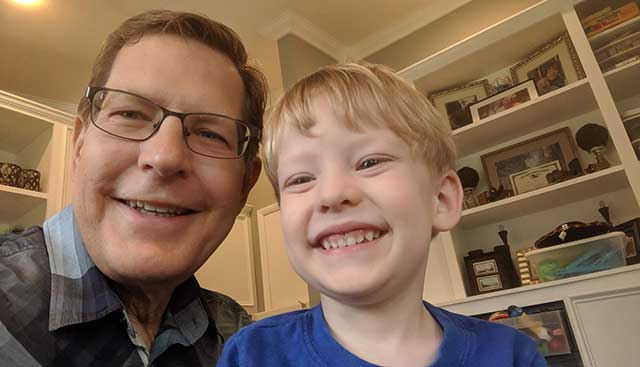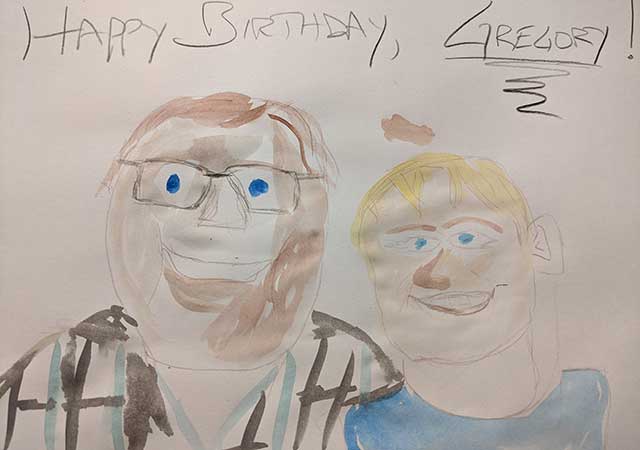
Bedside Art Visit During COVID-19 Yields a Special Birthday Gift
By Cat Thomas
Artist in Residence
For the past four months, I have been afforded the rare opportunity to offer visual arts bedside visits to inpatients at Moffitt Cancer Center during the COVID-19 pandemic. While it has been difficult at times, mostly due to the unknown variables of a pandemic, it has also been extremely rewarding. In reminiscing over all the meaningful experiences, I have had thus far, one visit stands out the most.
One day, I received a referral from Kim Little, one of the social workers at Moffitt, to work with a patient. Usually when we receive referrals, they say something along the lines of "patient would like an art bag" or "patient is anxious and would like a visit." This time however, the referral said, "patient would like to make something for his grandson’s birthday." I was immediately both excited and intrigued about this visit.
I got in touch with Kim and she explained that the patient wanted to make something special for his grandson, potentially a greeting card or something along those lines. I grabbed a few extra items for my cart and set out on my way.
When I got to Greg’s room, he was sitting in his chair working on his computer. I said "Hi! I’m Cat from Arts In Medicine! I hear you'd like an art visit." Greg’s face lit up as he invited me in. He expressed that he was very excited about my visit and we immediately started discussing what he wanted to do.
Rather than make a greeting card, Greg had decided that he wanted to replicate a photo he had of his grandson and himself. Now, I may have the credentials as an artist in residence, but I do not feel that I have the skills to adequately paint a portrait. I was very frank with Greg and told him that I would do my best to help him paint the picture, but that portraitures were not my forte. He did not seem to care, as he was just excited to have someone help guide him along the way, and work on this project together.
We formulated a plan and got to work. I got out the supplies and Greg pulled up the photo on his phone. He and his grandson were beaming! As we began painting, he proceeded to tell me all about his spunky grandson, who also shares his same name, and the special bond they share. It was obvious he was sad to be missing his grandson’s birthday.
We continued to paint and talked about life, traveling (one of his favorite past times) and the rest of his family members; whom had not been able to visit him due to the visitor restrictions in place because of the pandemic.
Greg confided in me that it had been difficult not being able to have his loved ones around. I think it is important to note here the importance of having some sort of contact with a person outside of the realm of people one would normally talk to during a regular hospital stay (nurses, doctors, nutritionists, etc.) Visitors, often family, friends and caregivers, are paramount to a person’s healing process as they provide safety and support in what can be a very isolating and tumultuous time. As artists in residence we are often, especially now, the only "visitor" someone has while staying at the hospital.
When we finished the painting, Greg was smiling from ear to ear. It was fantastic! The rendition really looked like the photo. We both took great pride in our accomplishment.
Before sending a photo of the painting to his family, we decided to take a photo of Greg holding up his masterpiece so that he could also send that to his family as well. He was beaming.
Greg sent the original photo, his masterpiece and the photo of himself holding up the masterpiece to his family so they could show it to mini Greg for his birthday. It was such a special moment. Greg expressed his gratitude for my help in bringing his idea to life and reiterated how nice it was to have someone to visit with and talk to. I told him I would come back by later in the week to see how he was doing.
I got an email a day or two later from Kim, asking me to go by Greg’s room again. When I got up there, he was nowhere to be found. I saw Kim and she told me Greg had gone for a scan and then asked if I had seen what was in his room. I had not noticed anything. She walked with me back to his room and that’s when I noticed the origami cranes hanging from his IV pole and the names written on each crane. He had made a special crane for each person on his care team, me included, and had hung them on his pole. While this gesture may seem insignificant to some, it meant the world to me.

Origami cranes are special because they are a symbol of hope and healing in Japan. Here, in the Arts In Medicine program, we have adopted the tradition of folding origami cranes as a therapeutic practice. Before people fold their cranes, they write healing messages for themselves or loved ones on the paper, setting an intention for well-being and prosperity. The fact that Greg had put me on one of his care team cranes was very touching.
Once we left the room, Kim mentioned she had some extra cranes at her desk and that it would be a nice expression of our own gratitude to place a few healing cranes in Greg’s room so that when he returned from his scan, he would be greeted with a room full of support and care. So, we did. We hung some on his blinds, his door and his TV, reciprocating the notion that he is indeed supported and cared for by a multitude of people.
While many patients may be going through some of the worst times of their lives with their cancer journey, especially now with the addition of a pandemic, it’s important to note the small gestures offered during their stay in the hospital that make their visit special and meaningful.
What we offer in the Arts In Medicine program is more than just an art activity. It’s a time to connect with others outside of their normal scope of care; offering space for healing, restoration and joy in an otherwise overwhelming and chaotic time.
